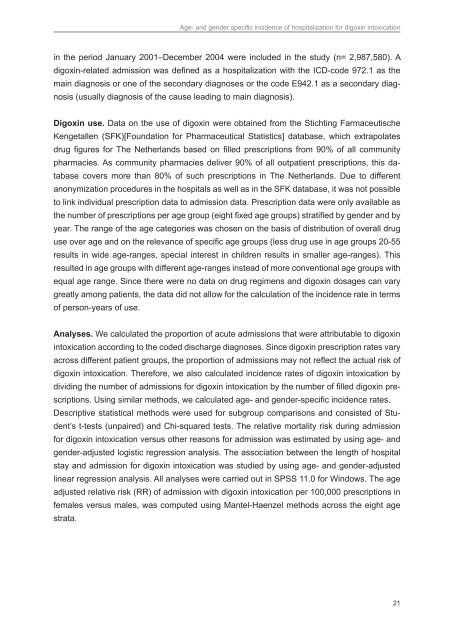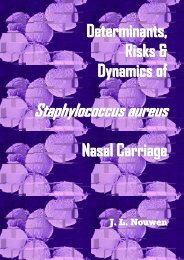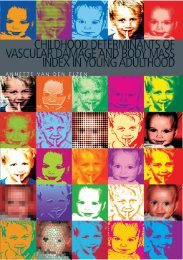Genetic susceptibility to adverse drug effects - Epidemiology ...
Genetic susceptibility to adverse drug effects - Epidemiology ...
Genetic susceptibility to adverse drug effects - Epidemiology ...
You also want an ePaper? Increase the reach of your titles
YUMPU automatically turns print PDFs into web optimized ePapers that Google loves.
Age- and gender specific incidence of hospitalization for digoxin in<strong>to</strong>xication<br />
in the period January 2001–December 2004 were included in the study (n= 2,987,580). A<br />
digoxin-related admission was defined as a hospitalization with the ICD-code 972.1 as the<br />
main diagnosis or one of the secondary diagnoses or the code E942.1 as a secondary diagnosis<br />
(usually diagnosis of the cause leading <strong>to</strong> main diagnosis).<br />
Digoxin use. Data on the use of digoxin were obtained from the Stichting Farmaceutische<br />
Kengetallen (SFK)[Foundation for Pharmaceutical Statistics] database, which extrapolates<br />
<strong>drug</strong> figures for The Netherlands based on filled prescriptions from 90% of all community<br />
pharmacies. As community pharmacies deliver 90% of all outpatient prescriptions, this database<br />
covers more than 80% of such prescriptions in The Netherlands. Due <strong>to</strong> different<br />
anonymization procedures in the hospitals as well as in the SFK database, it was not possible<br />
<strong>to</strong> link individual prescription data <strong>to</strong> admission data. Prescription data were only available as<br />
the number of prescriptions per age group (eight fixed age groups) stratified by gender and by<br />
year. The range of the age categories was chosen on the basis of distribution of overall <strong>drug</strong><br />
use over age and on the relevance of specific age groups (less <strong>drug</strong> use in age groups 20-55<br />
results in wide age-ranges, special interest in children results in smaller age-ranges). This<br />
resulted in age groups with different age-ranges instead of more conventional age groups with<br />
equal age range. Since there were no data on <strong>drug</strong> regimens and digoxin dosages can vary<br />
greatly among patients, the data did not allow for the calculation of the incidence rate in terms<br />
of person-years of use.<br />
Analyses. We calculated the proportion of acute admissions that were attributable <strong>to</strong> digoxin<br />
in<strong>to</strong>xication according <strong>to</strong> the coded discharge diagnoses. Since digoxin prescription rates vary<br />
across different patient groups, the proportion of admissions may not reflect the actual risk of<br />
digoxin in<strong>to</strong>xication. Therefore, we also calculated incidence rates of digoxin in<strong>to</strong>xication by<br />
dividing the number of admissions for digoxin in<strong>to</strong>xication by the number of filled digoxin prescriptions.<br />
Using similar methods, we calculated age- and gender-specific incidence rates.<br />
Descriptive statistical methods were used for subgroup comparisons and consisted of Student’s<br />
t-tests (unpaired) and Chi-squared tests. The relative mortality risk during admission<br />
for digoxin in<strong>to</strong>xication versus other reasons for admission was estimated by using age- and<br />
gender-adjusted logistic regression analysis. The association between the length of hospital<br />
stay and admission for digoxin in<strong>to</strong>xication was studied by using age- and gender-adjusted<br />
linear regression analysis. All analyses were carried out in SPSS 11.0 for Windows. The age<br />
adjusted relative risk (RR) of admission with digoxin in<strong>to</strong>xication per 100,000 prescriptions in<br />
females versus males, was computed using Mantel-Haenzel methods across the eight age<br />
strata.<br />
21









